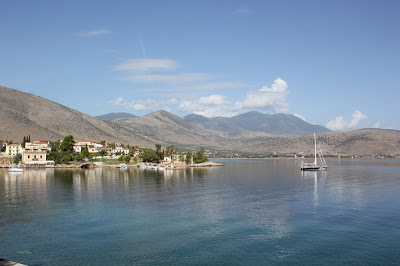A big high has
settled over the area, so not much sailing.
But that’s just fine because good natural harbors are almost
non-existent on volcanic islands, and the bottom drops off so steeply that
anchoring would be difficult in any kind of storm swell. The Greek wind god Aeolus must be with
us - it's been dead calm and perfect for seeing the volcanic Aeolian Islands!
There are seven Aeolian Islands, all part of Italy, and all easy day sails
apart. For example, one day we started
on Lipari with a visit to the archeological museum, motored to Stromboli over
lunch, and by 4pm we had anchored, secured our dinghy on the beach, and joined
a guided hike of Italian, Czech and Russian men up the mountain (you can't go past 400m up alone). It was a
bit comical to watch the German hiking group head out, with their impressive
array of hiking boots, gators, hiking sticks, fancy backpacks and helmets
already on, as little 8-year Maggie waited for her turn to start the climb in
her sneakers. It was a two and a half
hour climb to the 920 meter (~3,000 ft) summit, the last hour of which was steep
switchbacks. There was barely enough
room for us to squeeze by the German hiking group, who had stopped to rest. The suspense grew as we neared the top, where
we passed an ominous heat shield-type emergency
shelter, and could hear the rumble of the explosions in the crater and feel the
fine sand-like ash occasionally raining down on us. By sunset, we were perched on the edge of the
crater (absolute lack of guard rails is another sure sign the Italian legal
system must be different from ours), and every 20 minutes or so a big eruption
sent magma hurling into the air in front of us.
In fact, the eruptions are so predictable that any regular and mildly
explosive volcanic eruption is now called a “Strombolian eruption.” The most surreal part was the a capella accompaniment by the Chinese girl in the group who sang throughout the eruptions. If you've heard Chinese singing, you know what I mean. After about an hour,
we hiked/skied back down through an immense black sand field in the dark, no
moon to dim the brilliant Milky Way above.
Back in the village at the bottom by 10pm, that good Italian wood-fired
pizza never tasted so good! We found our
dinghy on the dark beach, motored back to the boat to shower off the black
layer of volcanic sand covering us, and slept like logs.
Still in the throes of volcano fever, the next day we
motored around to the north side of the island, where we drifted for hours,
watching the huge rocks from the eruption spray into the air and then careen
madly down the massive rockslide face of the volcano and plunge into the water
near (but not too near) us. The rocks
were falling so fast you could actually hear them “whizz” as they fell. And the slope was so unstable that the rocks
falling and triggering more rockslides sounded like a steady rain in the
background. We came back again at night
when all you could see was the glowing red shower of rocks blasting down and
finally extinguishing themselves in the water.
.jpg) |
Stromboli, the "Lighthouse of the Mediterranean"
|
.jpg) |
Hugo checks out the emergency shelter on top
|
.jpg) |
On top of Stromboli!
|
.jpg) |
Stromboli eruption
(note the edge of the cliff in the front of the photo,
just in front of us)
|
.jpg) |
Maggie enjoying the motor around Stromboli,
swinging from the halyards in her harness
|
.jpg) |
Sitting on the back deck of Tenho,
watching rocks from the eruption hurtle down
3,000ft and splash into the water
|
.jpg) |
Finding obsidian and pumice on the beach
(I think half the beach is now on our boat)
|


.jpg)
.jpg)
.jpg)
.jpg)
.jpg)
+(800x533).jpg)
.jpg)
.jpg)
.jpg)
.jpg)
.jpg)
.jpg)
.jpg)
.jpg)
.jpg)
.jpg)
.jpg)
.jpg)

.jpg)
.jpg)
.jpg)
.jpg)


.jpg)
.jpg)
.jpg)
.jpg)
.jpg)
.jpg)
.jpg)
.jpg)
.jpg)
.jpg)

.jpg)
.jpg)
.jpg)
.jpg)
.jpg)
.jpg)
.jpg)
.jpg)
.jpg)
.jpg)
.jpg)
.jpg)
.jpg)
.jpg)

